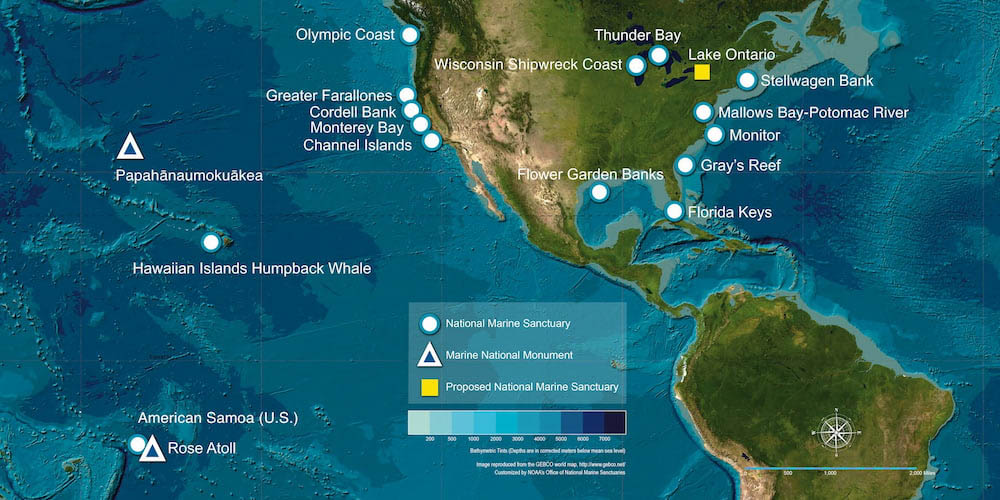Community leaders, local cultural organizations, and national conservation groups celebrated the designation of Wisconsin Shipwreck Coast National Marine Sanctuary, announced by the National Oceanic and Atmospheric Administration and the State of Wisconsin. Wisconsin Shipwreck Coast becomes our nation’s 15th marine sanctuary.
The 962-square mile Wisconsin Shipwreck Coast National Marine Sanctuary conserves 36 historic shipwrecks with exceptional archaeological, recreational, and national significance. The sanctuary includes Wisconsin’s two oldest shipwrecks and several others preserved almost completely intact due to Lake Michigan’s icy cold freshwater.
Kris Sarri, president and CEO of the National Marine Sanctuary Foundation, said, “I want to congratulate Governor Evers and Secretary Raimondo for designating Wisconsin Shipwreck National Marine Sanctuary to protect our Great Lakes’ maritime heritage. The sanctuary will foster new opportunities for exploration, education, research, and tourism that benefit the state’s coastal communities and bring increased attention to the Great Lakes role in the growth of our Nation.”
Mayor of Manitowoc Justin Nickels said, “The City of Manitowoc has worked toward this day for 12 years along with many wonderful partners at NOAA, the National Marine Sanctuary Foundation, the State of Wisconsin, and our municipal partners. We are excited that the Wisconsin Shipwreck Coast NMS will finally be a reality! The protection of this body of water and the shipwrecks with this designation, which lie forever at rest along our coast, will memorialize the rich history of our community and the men and women who built our city for generations before us. We are ready to tell the world our story with this National Marine Sanctuary along the shores of Lake Michigan!”
Mayor of Sheboygan Ryan Sorenson said, “Sheboygan is excited to have a National Marine Sanctuary right in our backyard. Sheboygan is known for being the Malibu of the Midwest, and this designation will help grow our tourism industry, while also preserving our history. Lake Michigan is our largest natural resource, and Sheboygan is very blessed to have this treasure right on our doorstep”
Greg Buckley, Two Rivers City Manager, said, “Two Rivers has been a strong advocate for the National Marine Sanctuary Designation since it was first proposed, and we are very excited that the designation will soon become reality. Our community had its origins on the water and, like so many Great Lakes cities, we are ‘turning our face back to the water’ as we pursue community redevelopment and renewal. Our Wisconsin Shipwreck Coast has some great stories to share with the rest of the world: we look forward to partnering with the State of Wisconsin and NOAA in the telling of those stories.”
Ted Neitzke, Mayor of The City of Port Washington, said, “We are excited for our state and region as well as the ability to honor our great heritage of commercial fishing and transportation on Lake Michigan. The lakeshore communities have worked collaboratively together to make this happen and it is a great example of how we can work together to preserve our history and honor our heritage. The City of Port Washington is grateful for all parties’ work and looks forward to celebrating the men and women who sail our great lake.”
“The Wisconsin Maritime Museum welcomes the Wisconsin Shipwreck Coast National Marine Sanctuary as a key partner in the protection, preservation, and promotion of Lake Michigan’s rich maritime heritage, states Catherine Green, the Executive Director of the Wisconsin Maritime Museum. “The research, resources, and national exposure that the sanctuary brings to our incredible maritime story, illustrated by the underwater museums on the bottom of Lake Michigan, will benefit our communities, our citizens, and certainly the invaluable cultural treasures that are Wisconsin’s Great Lakes shipwrecks.”
“We at Shedd Aquarium in Chicago celebrate the designation of the Wisconsin Shipwreck Coast National Marine Sanctuary, as this sanctuary will provide our communities the opportunity to look nature in the eye, explore the underappreciated ecological diversity of Lake Michigan, and understand the critical importance of protecting and restoring our freshwater habitats for the numerous endangered and threatened species that call them home,” said Andrea Densham, senior director of government affairs and conservation policy at Shedd Aquarium. “We thank Governor Evers, Secretary Raimondo and the Wisconsin Mayors for their vision, and we are eager to work with our partners to help our Wisconsin neighbors and visitors further develop living laboratories for community research, education, recreation, and wildlife conservation.”
From the 1800s to the early 20th century, wooden schooners and innovative steel steamships moved raw materials, agricultural products, and passengers over the icy cold waters of Lake Michigan and drove the prosperity and expansion of the United States. An estimated 1,200 shipwrecks have occurred in Lake Michigan, with several hundred in Wisconsin waters. Wisconsin boasts more individually listed shipwrecks on the National Register of Historic Places than any other state.
The shipwrecks in Lake Michigan preserve a legacy of industry and commerce that led to westward expansion. They embody the deep-rooted connections among communities of the Great Lakes and the entrepreneurial spirit of generations.
In December 2014, the State of Wisconsin, in partnership with the cities of Two Rivers, Manitowoc, Sheboygan, and Port Washington, and Manitowoc, Sheboygan, and Ozaukee Counties, submitted a community nomination to designate an area of Lake Michigan as a new maritime heritage sanctuary. A broad coalition of individuals and community organizations supported the nomination.
Wisconsin Shipwreck Coast joins America’s national marine sanctuaries as the essential network of protected waters, which sustain miraculous species, coastal communities, and our shared heritage. The National Marine Sanctuary System includes 15 national marine sanctuaries and two marine national monuments. These unique waters sustain critical, breathtaking marine habitats that provide homes to endangered and threatened species. They preserve America’s rich maritime heritage and are living laboratories for science, research, education and conservation. Sanctuaries also offer world-class outdoor recreation experiences for all ages and support local communities. Communities across the nation look to sanctuaries to protect nationally significant areas of our ocean, coasts, and Great Lakes.







